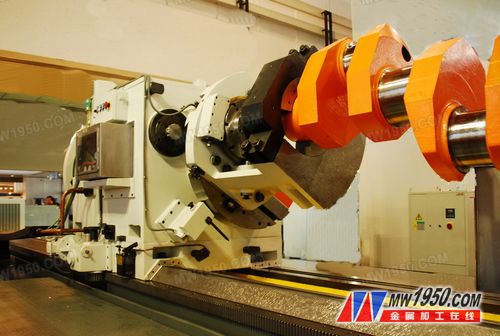For the crankshaft processing equipment, the grinding machine itself is undoubtedly the most accurate and complex, and the final machining machine for the product parts to meet the process requirements. Metal processing online experts have proposed that for workpieces with a length of more than 6 meters and a weight of more than 5 tons, the spindle neck and connecting rod neck roughness of the workpiece should reach Ra 0.4 -0.6, and the spindle neck and connecting rod neck diameter tolerance should be 0.008 mm. And the connecting rod neck straightness is 0.01 / 200 mm, the connecting rod neck cylindricity is 0.015 mm, the connecting rod neck is indexed plus or minus 15 seconds, and the large crankshaft can be machined by different angles and different eccentricity The requirements of the grinding machine are even more difficult.

Figure 1
According to the current equipment condition and processing technology, the machining of the crankshaft on the grinding machine is carried out in two steps, that is to say, the machining of the grinding spindle neck and the connecting rod neck are implemented separately in two models, which is mainly subject to equipment. Structural constraints and constraints. Generally, the grinding spindle neck is selected in a large-scale ordinary cylindrical grinding machine. The crankshaft is driven by the head frame of the cylindrical grinding machine. The spindle neck is gradually ground under the support of the two top and center frames, and the spindle neck is ground. In the process, the dimensional accuracy and technical requirements of the product have manual direct intervention, especially the control of the support force in the two directions of the center frame. This depends on the mastery of the operator, but it depends on human factors for a long time. And stable quality is difficult to achieve and unscientific. (Fig. 1) When machining the diameter of the connecting rod neck, a special crankshaft grinding machine is selected for processing. The head and tailstock chuck of the crankshaft grinder can be adjusted according to the central axis of the headstock and the eccentricity of the stroke of the crankshaft main journal and the connecting rod neck, so that the head and tailstock chucks are clamped around the center of the connecting rod neck. The center of rotation of the headstock of the headstock is used to grind the diameter of the neck of the connecting rod. (Figure II)

Figure II
Metal processing online expert Minhang Guo believes that because of the design of the crankshaft technology, there is a large eccentricity in the length mass distribution. If no measures are taken, the crankshaft will have uneven running phenomenon and centrifugal force during the machining rotation. The surface roughness of such grinding will definitely be affected. Therefore, a weighting device is arranged on the rear side of the head and tail frame of the machine tool, and the rotation of the head and tail frame can be improved and balanced by observing the condition of the driving motor current of the head and tail frame. Because of the structure of the crankshaft itself, when the headstock and the tailstock simultaneously clamp the two ends of the crankshaft, the unsynchronization of the headstock and the tailstock frame causes distortion of the crankshaft and affects the machining accuracy.
At present, in order to ensure the synchronization of the headstock and the tailstock, there are two kinds of transmission methods for the head and tailstock of the crankshaft grinding machine. One is to transmit through the synchronous shaft, and the head frame is transmitted as a main transmission through a series of transmission chains to the tailstock, so that they realize the crankshaft grinding machine. The head and tail frame chucks are synchronized to ensure that the crankshaft does not cause distortion during operation. This type of transmission is low in manufacturing cost, but there is inevitably a phenomenon that the mechanical transmission chain is too long and has a gap and wear, which brings a lot of inconvenience to the adjustment. The other is to use the head and tail frame rotation as the two-axis to adopt the numerical control synchronization technology, so that the rotation error of the head and tail frame during the rotation is minimized. Some manufacturers who use the head-and-tail frame rotation as the two-axis CNC synchronization technology, in order to prevent the head and tail frame from being out of step due to equipment failure and sudden power failure, causing equipment damage and product scrapping situation, the grinding wheel motor As the inertia of the large-diameter grinding wheel after the sudden power failure, it is used as a generator, and the generated electric power is supplied to the headstock and tailstock motor as a temporary power source, and the head and tailstock can be temporarily held to have a space for rotation in a short time to prevent the expansion of the fault. At the same time, in order to prevent the failure of the head and tail frame electrical system itself, the mechanical part of the head and tail frame is designed with the overrunning mechanism as the protection device. In the actual operation, the head frame is out of step due to the failure of the head frame speed control system template. It is precisely because of the protection of the device to prevent further expansion of the fault and to save nearly 300,000 RMB of workpiece scrap.
Led Strip Accessories,Rgb Led Rf Controller,Rgb Mini 24 Key Led Controller,11Key Rf Wireless Remote Controller
Shenzhen Huangtai Photoelectric Co.,Ltd. , https://www.szhtleds.com